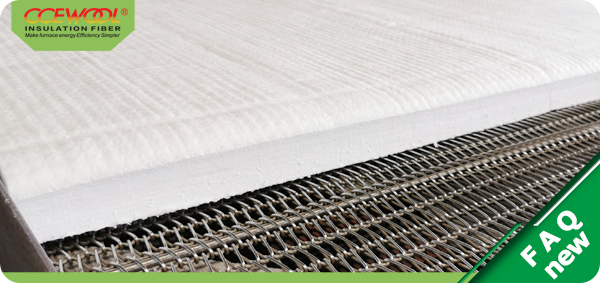Rotary Hearth Furnaces are a typical form of continuous high-temperature heating equipment, mainly used for heating steel billets prior to forging or rolling. These furnaces typically operate at around 1350°C, with a structure that includes a rotating furnace bottom and an annular heating chamber. Due to their long operation cycles and high thermal loads, they place greater demands on refractory lining materials.
CCEWOOL®'s refractory insulation blanket is widely used in the furnace roof, inner and outer rings, furnace bottom, and flue backing. With its low thermal conductivity, high-temperature resistance, and excellent flexibility, it has become a key component in modern fiber linings for Rotary Hearth Furnaces.
Performance Advantages of CCEWOOL® Ceramic Fiber Blankets
CCEWOOL® offers refractory insulation blankets in various temperature grades (1260°C, 1350°C, and 1430°C), allowing for customized selection based on the operating conditions of different furnace areas. The product offers the following advantages:
- Excellent insulation performance: Low thermal conductivity effectively blocks heat transfer.
- Outstanding thermal stability: Dimensionally stable at high temperatures and resistant to frequent thermal cycling.
- Lightweight and low heat capacity: Enhances thermal efficiency, shortens heat-up time, and reduces energy consumption.
- Flexible installation: Can be cut, compressed, or bent to fit different structures and anchoring systems.
- Easy installation and maintenance: Compatible with modules, castables, and other materials for convenient replacement and repair.
Among them, the high temperature ceramic insulation blanket is commonly used as the backing layer for the furnace roof and inner/outer rings. When combined with anchored fiber modules, it forms a stable multi-layer insulation system. In the furnace bottom and flue areas, it can also serve as the backing layer for fiber castables, providing both insulation and cushioning effects.
Typical Application Structures and Energy-Saving Effects
In the furnace roof and inner/outer ring structures of Rotary Hearth Furnaces, CCEWOOL® recommends first laying two layers of 30mm thick ceramic fiber blanket (compressed to 50mm), followed by stacking 250–300mm thick hanging or herringbone-structured fiber modules to form the main insulation system.
In the furnace bottom and flue sections, stainless steel anchors are used as a framework in combination with fiber castables and backing ceramic fiber blankets.
This composite structure significantly improves thermal insulation, lowers furnace shell temperature, reduces furnace weight and thermal inertia, and makes maintenance more efficient and convenient.
As a professional manufacturer of high-temperature refractory materials, CCEWOOL®'s refractory insulation blanket demonstrates the industry's pursuit of efficiency, energy savings, and structural light-weighting in Rotary Hearth Furnaces. Whether used as a primary insulation layer, a backing layer, or in combination with module systems, CCEWOOL® ceramic fiber blankets are a reliable choice for metallurgical thermal equipment.
Post time: Apr-14-2025


